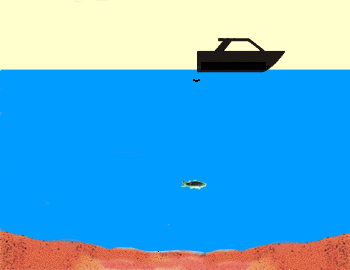

Sound waves travel inside of the Sun. When they strike the
surface, sound waves bounce back inside, like in the picture shown above.
By looking at the movement of the surface when the sound waves
bounce, scientists can learn about the temperature, density, and even
the motions inside the Sun. How do they do that?
Like with SONAR, scientists who study the Sun use sound waves to learn
about the inside of the Sun. Unlike SONAR, however, no one actually
has to send out the sound waves in the Sun. This is because the Sun's
convection zone actually makes sound waves
continuously all by itself. The Sun's sound waves usually start at the
surface and travel down into the interior. The sound waves curve around
because the inside is hottest in the core at the
middle of the Sun. When the waves bend it is called refraction.
Eventually the waves bend back to the surface, where they bounce again.
Some sound waves can skip around many times, traveling all around the Sun.
On earth, we cannot actually "hear" the solar sound waves because the
sound waves cannot travel through outer space.
Sound waves can only pass through gas (like the air) or liquids (like
the ocean), both of which are absent in outer space.
(Note: movies in which you hear explosions when space ships are blown up
are not presenting the facts correctly!)
The continuous bombardment of the solar surface by sound waves causes
the entire Sun to vibrate, much like the surface of a drum. It is
these vibrations that are either seen (but not heard)
on the Earth or recorded by cameras on space probes.
The movie is actually simpler than the real Sun because it shows
only a single vibration mode. In fact, just like an actual
drum, the vibration patterns are a lot more complicated, and
many modes are present. Only by
identifying and measuring the vibrations of the many different modes
can we figure out details about the inside of the Sun.
The area of science that uses sound waves to study the inside of the
Sun is called "Helioseismology". In the past twenty years, scientists
have learned many things about the solar interior, many of them have
been quite surprising.
Some of the things scientists have learned include:

 If you have read or seen "Hunt for Red October" or other submarine-based
adventures, you may know a little about SONAR. With SONAR, submarines
send out sound waves which bounce off nearby objects (like an enemy ship,
or a friendly whale). The echos are picked up and recorded and then used
to tell the crew what is nearby. Just like on submarines, some fishermen
use SONAR to find fish!
If you have read or seen "Hunt for Red October" or other submarine-based
adventures, you may know a little about SONAR. With SONAR, submarines
send out sound waves which bounce off nearby objects (like an enemy ship,
or a friendly whale). The echos are picked up and recorded and then used
to tell the crew what is nearby. Just like on submarines, some fishermen
use SONAR to find fish!
 This picture shows a greatly exaggerated view of how the
Sun vibrates. Click on the picture to see a short movie. In the movie,
we have colored the regions of the Sun moving outward red, while the
blue regions are moving inward, toward the center of the Sun.
If you could sit on the surface of the Sun (which you cannot because
you would burn up!), you would move up and down, like floating on an
ocean wave.
Scientists use something called the
Doppler effect to measure the vibrations.
This picture shows a greatly exaggerated view of how the
Sun vibrates. Click on the picture to see a short movie. In the movie,
we have colored the regions of the Sun moving outward red, while the
blue regions are moving inward, toward the center of the Sun.
If you could sit on the surface of the Sun (which you cannot because
you would burn up!), you would move up and down, like floating on an
ocean wave.
Scientists use something called the
Doppler effect to measure the vibrations.
What are other ways we use sound waves to "see" inside things? (hint: think about medical procedures )